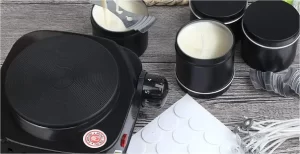Does Pre-Seasoned Cast Iron Need to be Seasoned?
Pre-seasoned cast iron is ready for immediate use, but seasoning it further can enhance its non-stick properties and longevity.
Cast iron cookware has been a staple in kitchens for centuries, known for its heat retention and even cooking. Pre-seasoned cast iron is a modern convenience, offering a layer of protection against rust and a foundation for a non-stick surface. This initial seasoning is a great start, but it’s not the end of the journey for your cookware.
Over time, with regular use, the seasoning can erode, leading to the potential sticking of food and increased vulnerability to rust.
While your pre-seasoned cast iron is indeed ready to cook with right out of the box, many seasoned chefs and home cooks alike recommend adding a few more layers of seasoning to fortify its surface. This not only boosts its non-stick prowess but also ensures a longer life for your pan.
The difference between a pre-seasoned pan and one that’s been seasoned multiple times lies in the depth of its patina and its resistance to wear and tear. So, while it’s not mandatory to season your pre-seasoned cast iron, doing so can offer a richer cooking experience.
Grasping Pre-Seasoned Cast Iron
Pre-seasoned cast iron is a term that might sound modern, but its roots trace back to ancient cooking traditions. The process of seasoning involves baking oil onto the cast iron to create a natural, non-stick surface.
Historically, our ancestors recognized the value of this process, ensuring their cookware was both durable and efficient. Fast forward to today, and manufacturers offer pre-seasoned options, providing a ready-to-use experience for the consumer.
Opting for pre-seasoned cookware offers several advantages, including immediate use, protection against rust, and a foundational non-stick layer.
The Need to Re-Season Pre-Seasoned Cast Iron
Over time, even the best-maintained skillets might show signs of wear. Perhaps you notice food sticking or a dull appearance.
These are indicators that your skillet craves a fresh layer of seasoning. Periodic re-seasoning rejuvenates your skillet, restoring its luster and non-stick properties.
The process is simple: clean, oil, and bake. This periodic care ensures your skillet remains a cherished kitchen companion for years.
Pre-Seasoned vs. Non-Pre-Seasoned Cast Iron: The Distinctions
The journey from raw material to your kitchen sees a divergence in the paths of pre-seasoned and non-pre-seasoned cast iron.
Pre-seasoned variants undergo a process where oils are baked onto them, establishing an initial protective and non-stick layer.
In contrast, non-pre-seasoned ones are devoid of this layer, requiring seasoning before use. Users often notice differences in maintenance, with pre-seasoned pans demanding less initial care.
Yet, both types promise durability, with proper care ensuring they last for generations.
Read More: Wholesome Asparagus and Potato Creations with Instant Pot
Initiating Your Journey with Pre-Seasoned Cast Iron Skillets
Embarking on your culinary adventures with a pre-seasoned cast iron skillet requires some basic knowledge. Clean your skillet with mild soap and water, drying it thoroughly.
Heat it gradually to avoid thermal shocks. As you begin cooking, opt for fatty foods like bacon, which enhance the skillet’s seasoning.
While the skillet is ready to use, be wary of acidic foods early on, as they can strip the seasoning.
Read More: Cast Iron Smells: How To Get Rid Of It
How to Season a Pre-Seasoned Cast Iron Pan?
Seasoning a pre-seasoned cast iron pan might seem redundant, but it’s a valuable process to enhance its non-stick properties and ensure longevity. Even though pre-seasoned pans come with an initial layer of protection, adding more layers can fortify its surface.
Cleaning the Pan
Step 1: Begin by washing the pan with mild dish soap and warm water. This ensures any residues or protective coatings from the manufacturer are removed.
Step 2: Dry the pan thoroughly using a cloth or place it on a stove on low heat to evaporate any remaining moisture.
Preparation for Seasoning
Step 3: Preheat your oven to 375°F (190°C). This temperature is ideal for the seasoning process.
Step 4: Using a cloth or paper towel, apply a thin layer of vegetable oil or any other high smoke point oil to the entire surface of the pan, both inside and out.
Seasoning Process
Step 5: Place the oiled pan upside down in the preheated oven. It’s a good idea to place a baking sheet or aluminum foil below the pan to catch any drips.
Step 6: Let the pan bake for an hour. The heat allows the oil to bond with the iron, creating a protective and non-stick layer.
Cooling and Storing
Step 7: After an hour, turn off the oven and let the pan cool inside. This gradual cooling prevents any potential warping.
Step 8: Once cooled, store your cast iron in a dry place. If stacking with other pans, consider placing a paper towel in between to prevent scratching.

Olive Oil’s Significance in Cast Iron Seasoning
Olive oil, with its myriad of health benefits, also plays a pivotal role in cast iron seasoning.
Compared to other oils, olive oil provides a smooth, non-stick surface without imparting strong flavors to your food.
To season with olive oil, lightly coat your skillet and bake it upside down in an oven.
This process not only enhances the non-stick quality but also imparts a subtle, delightful flavor to dishes.





